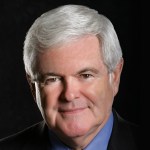In late February, a historic event occurred on the moon. An American vehicle, for the first time in 51 years, landed on the moon. Not since Apollo 17 have the Americans been back on the moon. Equally amazing, this new vehicle, a moon lander, was in fact at the South Pole. No American vehicle had ever gone to the South Pole. And that’s important, because you see a different part of space and the moon in the South Pole, area is different, has a lot more water, and has a lot of other interesting factors that we’ve been fascinated by, but haven’t been able to get to.
In many ways, the Odysseus lunar lander is a tribute to President Donald J. Trump, who decided when he came into office that we needed to reestablish the dynamic entrepreneurial spirit, the sense of adventure and excitement that President John F. Kennedy had created at Rice University in 1962, when he announced that we would put a man on the moon inside the decade. And we did that. [His] speech [was] in 1962. Seven years later, we had landed a man on the moon.
And we’re off and running now, with private sector entrepreneurs, like Elon Musk, and Cam [sic] for seeing a whole new level of energy, a new level of drive, and, frankly, a lot more money, because they bring their resources to match up with the government’s resources, and Intuitive Machines, which is the company that built the lunar lander, is part of a series including axiom space, which are working to develop a whole series of private sector opportunities, including the first commercial space station.
Why does this all matter? Because with Musk’s contribution in developing something which Congressman Bob Walker and I had worked on years ago, and that is a reusable rocket, one that could come back down, be used over and over again, [the] feeling now is that some of SpaceX’s rockets may get used 10 to 20 times before they have to be replaced. The drop in cost has been phenomenal. We now do about 10% of the price that we had before Elon Musk came along. And when his starship has developed, which will have 36 rocket engines, it’s going to be the most powerful rocket ever built, and it’s being designed to be reusable. So again, you’re gonna get into constant motion, much lower cost, much greater lifting capacity. And we’re at the beginning of a new era. And that’s why it was exciting to see us go back to the moon, and to know that people are going to follow.
The current plan is by 2025 or 2026, we’ll have the first team landing on the moon again. And this time, we’re going to be on the moon to stay, not just to visit briefly, not just to explore, but to actually begin building a capacity, starting with the kind of station we have in Antarctica, self-contained, available for scientists, gradually expanding, and then becoming ultimately a launching point for learning how we can go to Mars. I think this is an exciting time, and I hope you find it as interesting as I do.



















Commentary
Our commentary partners will help you reach your own conclusions on complex topics.
‘Overblown’: Americans debate the merits of DEI policies
Yesterday Dr. Frank Luntz‘Biased’: What Americans think of ‘mainstream media’
Friday Dr. Frank Luntz‘Getting rid of them’: Americans discuss Trump and immigration
Feb 14 Dr. Frank Luntz‘Woke’: Why some Biden 2020 voters backed Trump in 2024
Feb 6 Dr. Frank LuntzSpaceX, Intuitive Machines herald a new space age
By Straight Arrow News
On Feb. 22, the lunar rover Odysseus made history as the first commercial space vehicle to accomplish a soft landing on the moon. The achievement is also a hallmark of the increasing privatization of space exploration and future space travel, with private companies like SpaceX and Intuitive Machines playing key roles alongside federal governments.
Straight Arrow News contributor Newt Gingrich welcomes these developments and says that they herald an exciting new age of space travel and exploration. Gingrich indicates that private companies might even dream of putting a man on Mars in the years ahead.
Why does this all matter? Because with Musk’s contribution in developing something which Congressman Bob Walker and I had worked on years ago, and — that is — a reusable rocket, one that could come back down, be used over and over again, [the] feeling now is that some of SpaceX’s rockets may get used 10 to 20 times before they have to be replaced.
The drop in cost has been phenomenal. We now do about 10% of the price that we had before Elon Musk came along. And when his Starship is developed, which will have 36 rocket engines, it’s going to be the most powerful rocket ever built, and it’s being designed to be reusable. So again, you’re gonna get into constant motion, much lower cost, much greater lifting capacity. And we’re at the beginning of a new era. And that’s why it was exciting to see us go back to the moon and to know that people are going to follow.
The current plan is by 2025 or 2026, we’ll have the first team landing on the moon again. And this time, we’re going to be on the moon to stay, not just to visit briefly, not just to explore, but to actually begin building a capacity, starting with the kind of station we have in Antarctica, self-contained, available for scientists, gradually expanding, and then becoming ultimately a launching point for learning how we can go to Mars. I think this is an exciting time, and I hope you find it as interesting as I do.
In late February, a historic event occurred on the moon. An American vehicle, for the first time in 51 years, landed on the moon. Not since Apollo 17 have the Americans been back on the moon. Equally amazing, this new vehicle, a moon lander, was in fact at the South Pole. No American vehicle had ever gone to the South Pole. And that’s important, because you see a different part of space and the moon in the South Pole, area is different, has a lot more water, and has a lot of other interesting factors that we’ve been fascinated by, but haven’t been able to get to.
In many ways, the Odysseus lunar lander is a tribute to President Donald J. Trump, who decided when he came into office that we needed to reestablish the dynamic entrepreneurial spirit, the sense of adventure and excitement that President John F. Kennedy had created at Rice University in 1962, when he announced that we would put a man on the moon inside the decade. And we did that. [His] speech [was] in 1962. Seven years later, we had landed a man on the moon.
And we’re off and running now, with private sector entrepreneurs, like Elon Musk, and Cam [sic] for seeing a whole new level of energy, a new level of drive, and, frankly, a lot more money, because they bring their resources to match up with the government’s resources, and Intuitive Machines, which is the company that built the lunar lander, is part of a series including axiom space, which are working to develop a whole series of private sector opportunities, including the first commercial space station.
Why does this all matter? Because with Musk’s contribution in developing something which Congressman Bob Walker and I had worked on years ago, and that is a reusable rocket, one that could come back down, be used over and over again, [the] feeling now is that some of SpaceX’s rockets may get used 10 to 20 times before they have to be replaced. The drop in cost has been phenomenal. We now do about 10% of the price that we had before Elon Musk came along. And when his starship has developed, which will have 36 rocket engines, it’s going to be the most powerful rocket ever built, and it’s being designed to be reusable. So again, you’re gonna get into constant motion, much lower cost, much greater lifting capacity. And we’re at the beginning of a new era. And that’s why it was exciting to see us go back to the moon, and to know that people are going to follow.
The current plan is by 2025 or 2026, we’ll have the first team landing on the moon again. And this time, we’re going to be on the moon to stay, not just to visit briefly, not just to explore, but to actually begin building a capacity, starting with the kind of station we have in Antarctica, self-contained, available for scientists, gradually expanding, and then becoming ultimately a launching point for learning how we can go to Mars. I think this is an exciting time, and I hope you find it as interesting as I do.
Why Musk and DOGE are 100% doing the right thing
On Gaza and Ukraine, Trump’s answers are better than none
My White House visit left me more hopeful than ever
Trump moves at breakneck speed to enact bold changes
Breaking down Trump’s incredible inaugural address
Underreported stories from each side
Attorney General Pam Bondi alleges FBI agents withheld Epstein documents
66 sources | 7% from the left Getty ImagesDonald Trump should be banned from next G7 meeting in Alberta, Jagmeet Singh says
32 sources | 11% from the right Getty ImagesLatest Stories
Trump to sign executive order to make English official language of US
The ceasefire between Hamas and Israel is nearing its end, will peace hold?
What can Conan O’Brien learn from past Oscars hosts?
Zelenskyy leaves WH early; Trump says he can come back when ‘ready for peace’
Why pilots near Australia were unaware of a Chinese naval drill: Report
Popular Opinions
In addition to the facts, we believe it’s vital to hear perspectives from all sides of the political spectrum.
America is a republic with a legislative sausage factory
26 mins ago Star ParkerJoy Reid firing at MSNBC rooted in systemic bigotry
2 hrs ago Dr. Rashad RicheyRFK Jr.’s war on psychiatric meds risks decades of progress
Yesterday Jordan ReidWhy didn’t Netflix, Oscars vet Karla Gascón’s social media?
Wednesday Adrienne Lawrence